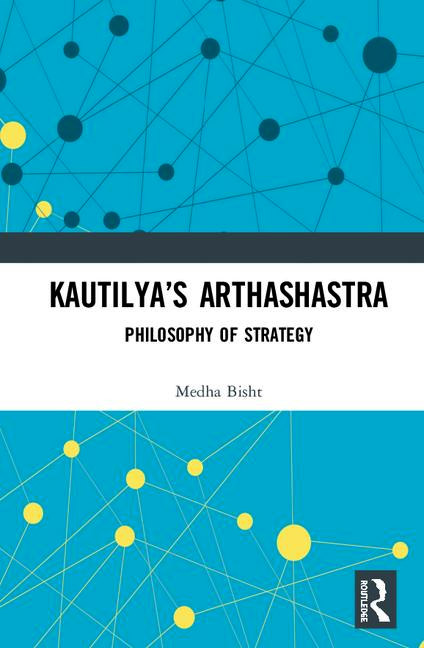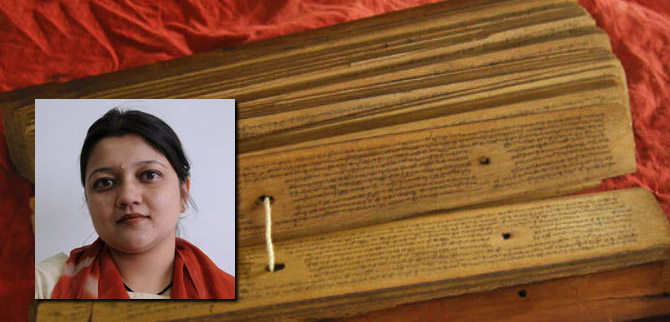Reading Kautilya’s Arthashastra – In between philosophy and strategy by Dr Medha Bisht
Medha Bisht is a Ph.D in Diplomatic Studies, Jawaharlal Nehru University. She is a Senior Assistant Professor, Department of International Relations, South Asian University. Her Ph.D was on Multistakeholder Negotiations on Security and Development (2010). She has worked as Fellow with Institute for Defence Studies and Analyses, Ministry of Defence, India, where she was researching on Bhutan and water politics and as an Associate with Institute of Social Studies Trust, with special consultative status with ECOSOC (UN), where she worked on gender and development. Profile: http://sau.int/faculty/faculty-profile.html?staff_id=51
Her book, ‘Kautilya’s Arthashastra: Philosophy of Strategy’ is under publication with Routledge (London and New York).
Weblink to the Book
https://www.crcpress.com/Kautilyas-Arthashastra-Philosophy-of-Strategy/Bisht/p/book/9781138553071
https://www.amazon.com/Kautilyas-Arthashastra-Philosophy-Medha-Bisht/dp/1138553077
https://www.amazon.in/Kautilyas-Arthashastra-Philosophy-Medha-Bisht/dp/1138553077
 Classics are subliminal in character enthralling minds across generations. While composed in a specific historico-cultural moment, the questions they seek to address often have a universal appeal. In the case of Arthashastra, the text emphasises on understanding the ‘political’.
Classics are subliminal in character enthralling minds across generations. While composed in a specific historico-cultural moment, the questions they seek to address often have a universal appeal. In the case of Arthashastra, the text emphasises on understanding the ‘political’.
Thus, non-western classics not only invite us to understand multiple thoughtways, but also familiarize us with a genre of epistemic practices which stemmed from specific geo-cultural spaces. Significantly, reading classics helps emancipate ideas which are non-western and helps decolonising disciplines such as International Relations, which were primarily built on the experience and the intellectual thought of the Anglo-American world. A classic reflection of such unconscious cognitive bias is indicated through interpretations of Kautilya’s Arthashastra, a text, which was composed around the fourth century BCE. The treatment of the text is thereby driven by a paradigmatic approach, and little effort has been given to understand the philosophical/ideational underpinnings of Hindu philosophy which inspired the grand strategic design offered in Kautilya’s Arthashastra.
The inspiration behind my forthcoming book (Kautilya’s Arthashastra: Philosophy of Strategy published by Routledge: London and New York), were some of these haunting intellectual curiosities. A striking pattern, which emerged from my reading of Arthashastra, was its emphasis on dharma interpreted as order, and how maintaining and regulating this order, became the teleological purpose behind the idea of state and statecraft. Dharma, in Hindu philosophy was not equated with a theocratic framework, but understood more as a way of life, which became the normative guide for the king and subjects in political and social affairs. In the idyllic state of Kautilya, dharma thus became the reflective basis for “knowing, understanding and judging” the political phenomenon.
While the book offers an engagement with concepts used in international relations as they give meaning to strategy in Arthashastra, it also extrapolates insights from disciplines such as grand strategy, international relations theory and political theory. An important insight from my reading of Arthashastra relates to the nature of conversation between western IR and non-western IR and I caution one to refrain from a binary understanding of the two. Though Arthashastra was a strategic text, it does offer epistemic value to concepts as employed and theorised in the discipline of International Relations. The book therefore facilitates a dialogue between meanings associated with the Hindu concept dharma, and how these meanings move when one invokes concepts such as power, morality and order.
There are two factors significant for reading Arthashastra.
First, the idea of political and the way it was envisioned in Arthashastra. This helps us understand the strategic wisdom that comes out from this pre-westphalian text. In this context terminologies such as upadhas (tests of deception), upayas (stratagems), sadgunya (six measures of foreign policy) and saptanga (seven elements of state power) start getting their meaning. While defining the term political can be a daunting task to begin with, the questions of what, how and why can offer useful pointers. First (what), it draws our attention to central objects which determine the nature of political, second (how), it inspires us to ask ways through which the question of political was approached and third (why), it puts us in a more reflexive mode, where we question the very purpose of emphasising the political. For a more revisionist understanding of Arthashastra , which I emphasise upon, the third question is important because it spells out the reason for which the idea of state and statecraft became important. I say this because power served the specific purpose of maintaining order and stability.
This relativist meaning of power makes the understanding of ideational underpinnings a categorical imperative, which in turn directs us to understand the interdependent relationship between Hindu authoritative texts such as dharmashastras and arthashastras. The relevance of dharmashastras to arthashastras stem from the important place and legitimacy that the former occupied in Hindu thought – not only in emphasising the role of the king but also in terms of the varna-ashramas and the theory of karma. Where the varna ashramas laid down the duties and rules of the social system, the theory of karma psychologically sanctioned the observance of the caste duties, where one had personal responsibility of following ones duty in a virtuous manner. Varna dharma and karma dharma thus become instructive frameworks for underlining the relevance of maintaining social order.
Dharma was thus indirectly related to the sustenance of social order, and was equally applicable to the king as it was to a common man. Thus, concept of dharma here can be interpreted as order, and maintaining and regulating this order, became the political objective of state and statecraft. The purpose of political was, therefore hinged towards maintaining order both at the internal and external level. Hence, Kautilya’s Arthashastra took both the macro and micro challenges into account, where policies were crafted based on the notion of interrelatedness, which I would say shaped the architecture for governance and strategy broadly identified with the idea of state and statecraft in classical Indian thought. Thus Kautilya’s reference to authoritative texts (dharmashastras and nitishastras) can be perceived as serving strategic, instrumental purpose for underlining the need of maintaining societal order (saptanga theory) in secular terms and introducing the vocabulary of mandala – the circle of states in spatial terms. The spatial dimension of the theory of mandala is instructive of a balancing/interactionist act in a fluid-changing uncertain external environment. To regulate this balance in the mandala, Kautilya suggested a six-fold measure on foreign policy (sadgunya theory), which is indicative of an adaptive strategy, obviating any logic for rigidity in foreign policy.
Thus, given the value that Arthashastra holds for the discipline of strategy and diplomacy, the notion of balance foregrounded in the logic of order reinforces the normative inclination of this text as a non-western contribution to traditions of political thought and diplomatic practice. The use of upadhas (secret tests) are extremely important as they perpetuate the notion of doing ones duty which was akin to following ones dharma.This understanding offers insights on the meanings through which political was conceptualized and even intertwined with the social in Arthashastra.
Second, I would discuss the philosophical roots for defining the political. This is important for familiarizing oneself with Hindu epistemic insights which stem from Arthashastra. The concept of Anvikshiki, defined as logical reasoning, which gave a distinct meaning to science of politics becomes important in this context and is therefore is also the methodological hook for anchoring ideas pertaining to political. Methodologically, Arthashastra emphasises the importance of Anvikshiki (logic of reasoning) for the generation of knowledge, which it considers to be a lamp for directing the meaning of political. Meaning of political, therefore was not parochial, and was constituted through a dialogical engagement between the science of dharma, the science of economics and the science of politics. It is most interesting that Anvikshiki is symbolically signified in Arthashastra through a dialectics between three seemingly contradictory modes of thought in Indian philosophy- Samkhya, Yoga and Lokayata. Samkhya by emphasising dualism elevated the importance of discerning distinct qualities formed through the fusion of purusa (soul) and prakriti (matter), Yoga emphasised on discipline/meditation, recognizing the need to discipline human nature and Lokayata emphasised on a materialist pursuits of the state. In many ways through Anvikshiki, Kautilya’s understanding of the state emphasised a balance between the material and spiritual elements. A discussion on these philosophical strands becomes important because of a significant verse in Arthashastra, which states – “Samkhya, Yoga and Lokayata these constitute philosophy” (The Kautilya Arthashastra 1.2.10:6).
This methodological anchor in Arthashastra becomes an effective departure point for understanding the concept of state, where the notion of political had a sense of holism attached to it, ranging from the macrocosm to the microcosm. Where at a macro level, the idea of a state became a moral agency facilitating order (understood) as dharma, at the micro level , the idea of state also inspired the four ends of life (purusharthas) – expressed as ethical goodness (dharma), wealth and power (artha), pleasure (kama) and spiritual transcendence (moksha). Arthashastra further elaborates on the outstanding qualities of the state, which is indicative of the capacity of state (saptanga theory) and how should stratagems and techniques when employed through statecraft can help state achieve the outstanding features. It is in this respect that qualities of the feasible and desirable vis-à-vis political in Arthashastra have been reconciled with each other. This methodology in Arthashastra is indicative of a distinct epistemic practice, which goes beyond the framework of positivism, as an empiricist methodology and directs us to a distinct intellectual trajectory where Hindu values and philosophy have been synthesised to address questions related to state and statecraft, not in a compartmentalised but in a composite /holistic manner. The relevance of methodology adopted in Arthashastra is therefore both cognitive and evaluative.
What is the relationship between strategy, state and statecraft and what role do morality, power and order play in this regard are questions that the Book seeks to address. However, while revisiting canons are important, one also needs to be a guarded, cautious and a reflective reader. In order to minimise an essentialist reading of canons and apply its utility to contemporary India it is important that we remain open to interpretations of ancient concepts when we transpose them to modern times. Dharma, emerges as a major concept in Arthashastra, but has also been central to larger Indian tradition, as articulated in philosophical and political thought of Rabindranath Tagore and Mahatma Gandhi. The challenge therefore is to draw out the political wisdom from canons like Arthashastra and simultaneously also be reflective of broad patterns which guided the strategic mind of Kautilya two thousand years ago.
© Dr Medha Bisht


